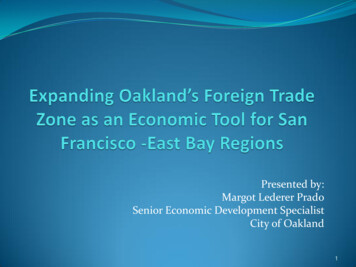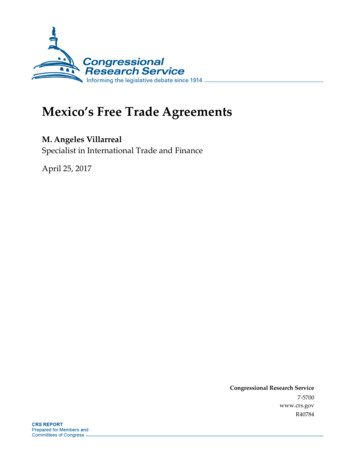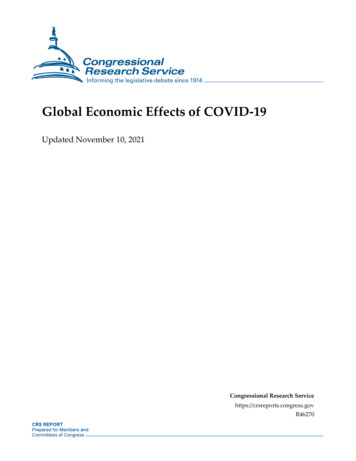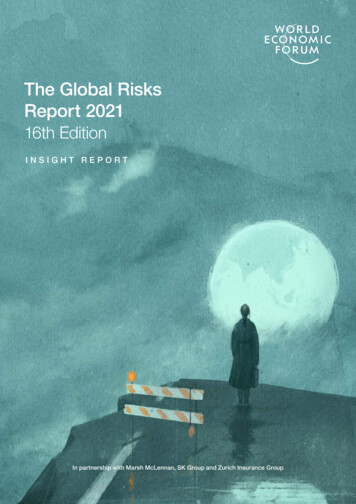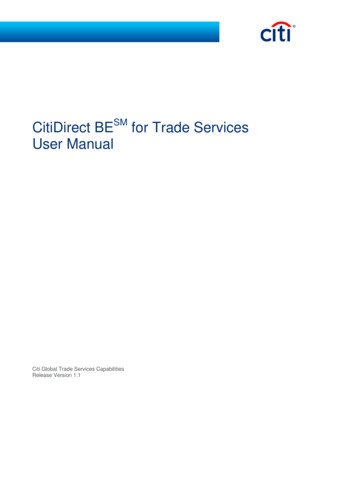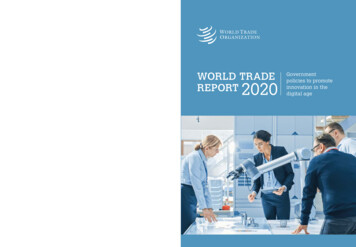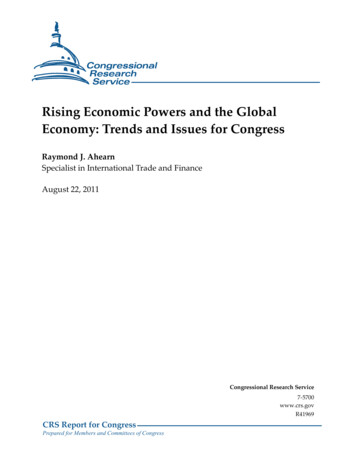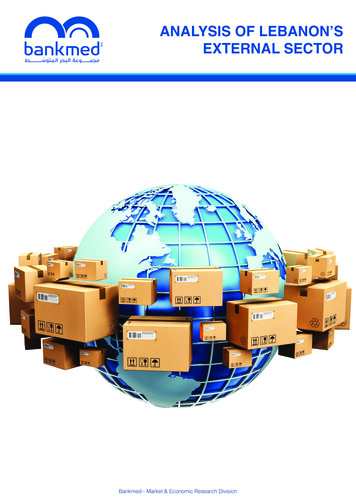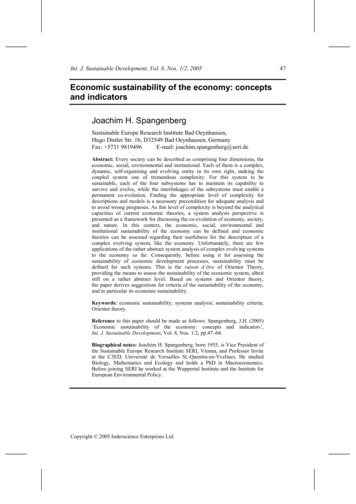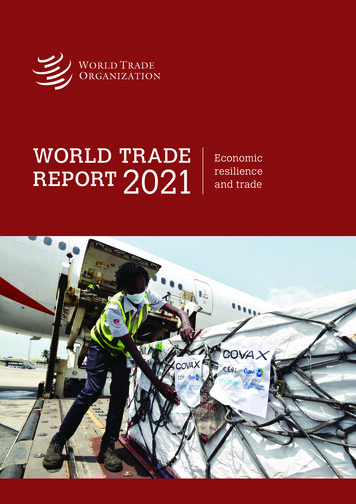
Transcription
WORLD TRADEREPORT2021Economicresilienceand trade
What is the WorldTrade Report?The World Trade Report is anannual publication that aims todeepen understanding abouttrends in trade, trade policyissues and the multilateraltrading system.What is the 2021Report about?The 2021 World Trade Reportexplores current debates abouteconomic resilience in a globaleconomy increasingly subjectto natural and man-madeshocks, and explains howthe WTO can contribute toimproving economic resilience.Find out moreWebsite: www.wto.orgGeneral enquiries:enquiries@wto.orgTel: 41 (0)22 739 51 11
CONTENTSContentsAcknowledgements and disclaimerAbbreviations and symbolsForeword by the WTO Director-GeneralExecutive summaryA. Introduction1. Vulnerability and resilience: two sides of the same globalization coin2. More resilience requires more, not less, global economic cooperationB. Why economic resilience matters1. Introduction2. Economies are exposed to risks and shocks3. Disruptions and shocks can cause significant loss of life and severe economic impact4. How do shocks impact international trade?5. Economic and trade policy response to shocks6. Building and supporting economic resilience has become a key strategyto reduce business interruptions and economic losses caused by shocks7. ConclusionC. The role of trade in economic resilience1. Introduction2. Trade can be a spreader of shocks3. Trade can enable countries to better prepare for, cope with, and recover from shocks4. The role of trade diversification in resilience5. ConclusionD. The role of international cooperation in building economic resilience1. Introduction2. Why does international cooperation matter for economic resilience and what forms does it take?3. International cooperation on non-trade policies can help reduce risk andvulnerabilities and enhance resilience4. International cooperation on trade policies can reduce risk and vulnerabilities5. International cooperation on trade policies can help cope with shocks6. International cooperation on trade policies can help recover after shocks7. ConclusionE. ConclusionOpinion piecesStephane Hallegatte, “Beyond the aggregate: defining and measuring households’ resilience”Ralph Ossa, “A simple measure of economic resilience”Susan Lund, “How more resilient supply chains could reshape global trade”Alison Gillwald, “Multiple economic resilience challenges for Africa in a rapidlydigitalizing global economy”Chad P. Bown, “Semiconductors and pandemic resilience”Mami Mizutori, “The business case for trade, risk reduction and resilience”ebnem Kalemli-Özcan, “The economic case for global vaccinations”Ellen ‘t Hoen, “Vaccine knowledge needs to be a global public good”Patrick Gaulé, “Patents and the availability of essential goods in crises:the case of COVID-19 vaccines”BibliographyTechnical notesList of figures, tables and boxesWTO membersPrevious World Trade 002012052061
WORLD TRADE REPORT 2021AcknowledgementsThe World Trade Report 2021 was prepared underthe general responsibility and guidance of AnabelGonzález, WTO Deputy Director-General, andRobert Koopman, Director of the Economic Researchand Statistics Division. The report was coordinatedby Eddy Bekkers and José-Antonio Monteiro.The authors of the report are Marc Auboin, MarcBacchetta, Francesco Bellelli, Cosimo Beverelli,Eddy Bekkers, Emmanuelle Ganne, John Hancock,Katharina Laengle, Kathryn Lundquist, José-AntonioMonteiro, Roberta Piermartini, Yves Renouf, VictorStolzenburg and Ankai Xu (Economic Research andStatistics Division).The following divisions in the WTO Secretariatprovided valuable comments on drafts of the report:Agricultural and Commodities Division (JonathanHepburn, Melvin Spreij and Christiane Wolff),Development Division (Shishir Priyadarshi andMichael Roberts), Intellectual Property, GovernmentProcurement and Competition Division (JianningChen, Reto Malacrida, Philippe Pelletier, AstghikSolomonyan and Antony Taubman), Legal AffairsDivision (John Adank, Mireille Cossy and Juan PabloMoya Hoyos ), Rules Division (Seref Coskun andClarisse Morgan), Trade and Environment Division(Rainer Lanz and Karsten Steinfatt), Trade in Servicesand Investment Division (Elena Bertola, AntoniaCarzaniga, Xiaolin Chai, Dale Honeck, Markus Jelitto,Juan Marchetti, Martin Roy, Lee Tuthill and RuosiZhang) and Trade Policy Review Division (WillyAlfaro). Director-General Ngozi Okonjo-Iweala andTrineesh Biswas from the Office of the DirectorGeneral provided valuable advice and guidance.ExternalcontributionswerereceivedfromChad Bown (Peterson Institute for InternationalEconomics), Stephane Hallegatte (World Bank),Patrick Gaulé (University of Bath), Alison Gillwald(Research ICT Africa), Susan Lund (McKinsey),Ellen ‘t Hoen (Medicines Law & Policy), ŞebnemKalemli-Özcan (University of Maryland), Mami Mizutori(United Nations Office for Disaster Risk Reduction)and Ralph Ossa (University of Zurich). Contributionswere also received from the following WTO Chairs,in coordination with the Knowledge and InformationManagement, Academic Outreach and WTO ChairsProgramme Division (Mustapha Sadni Jallab withsupport from Sandra Rossier and Qing Ye): LeilaBaghdadi (University of Tunis), Tabitha Kiriti-Nganga(University of Nairobi), and Boopen Seetanah, VerenaTandrayen-Ragoobur and Jaime De Melo (Universityof Mauritius).The following individuals from outside the WTOSecretariat also provided useful comments onearly drafts of the report: Giovanna Adinolfi, DillonAlleyne, Venkatachalam Anbumozhi, Leila Baghdadi,Amrita Bahri, Richard Baldwin, Cecilia Bellora, ChadBown, Lino Pascal Briguglio, Andrew Dobson, LionelFontagné, Emily Gray, Vanessa Gray, StephaneHallegatte, Şebnem Kalemli-Özcan, Tabitha Kiriti,Jenty Kirsch-Wood, Mia Mikic, Julia Nielson,Hildegunn Kyvik Nordås, Keith Nurse, Ralph Ossa,Diane Quarless, Michele Ruta, Ana Maria Santacreu,Boopen Seetanah, Robert Teh, Frank Van Tongerenand Irina Zodrow.Research assistance was provided by André Brotto,Akanksha Burman, Carolin Graf, Yuliia Kucheriava,Minhee Lee, Sergio Martinez Cotto, Lucas OuriquesPoffo, Feiyang Shi, and Enxhi Tresa. Additional chartswere provided by Barbara D’Andrea with supportfrom Shradha Bhatia and Yin Yang.The text production of the Report was managedby Anne Lescure and Diana Dent of the EconomicResearch and Statistics Division. The productionof the Report was managed by Anthony Martin andHelen Swain of the Information and External RelationsDivision. William Shaw and Helen Swain edited thereport. Gratitude is also due to the translators in theLanguage and Documentation Services Division forthe high quality of their work.DisclaimerThe World Trade Report and its contents are the sole responsibility of the WTO Secretariat, exceptfor the opinion pieces written by the external contributors and the boxes prepared by the WTO Chairs,which are the sole responsibility of their respective authors. The Report does not reflect the opinionsor views of members of the WTO. The authors of the Report also wish to exonerate those who havecommented upon it from responsibility for any outstanding errors or omissions.2
ABBREVIATIONS AND SYMBOLSAbbreviations and symbolsACP Organisation of African, Caribbeanand Pacific StatesAoA Agreement on AgricultureAPEC Asia-Pacific Economic CooperationASEAN Association of Southeast AsianNationsCEMAC Economic and Monetary Communityof Central AfricaCOMESA Common Market for East andSouthern AfricaCOVID-19 coronavirus diseaseC-TAP COVID-19 Technology Access PoolDSU WTO Dispute SettlementUnderstandingIP intellectual propertyIPR intellectual property rightsLDC least-developed countryMERCOSUR Southern Common MarketMFN most-favoured nationMSME micro, small and medium-sizedenterpriseNGO non-governmental organizationOECD Organisation for EconomicCo-operation and DevelopmentOIE World Organisation for Animal HealthPPE personal protective equipmentQR quantitative restrictionEAC East African CommunityR&D research and developmentEGA Environmental Goods AgreementRTA regional trade agreementEIF Enhanced Integrated FrameworkSACU Southern African Customs UnionEM-DAT Emergency Events DatabaseSCM subsidies and countervailing measuresFAO Food and Agriculture Organizationof the United NationsSPS sanitary and phytosanitaryFDI foreign direct investmentSTDF Standards and Trade DevelopmentFacilityFTA free trade agreementTFA WTO Trade Facilitation AgreementGATS General Agreement on Tradein ServicesTRIMsAgreement WTO Agreement on Trade-RelatedInvestment MeasuresGATT General Agreement on Tariffsand TradeGDP gross domestic productGHG greenhouse gasGPA Agreement on GovernmentProcurementGVC global value chainHS Harmonized SystemIATA International Air Transport AssociationICC International Chamber of CommerceICT information and communicationstechnologiesTRIPS trade-related aspects of intellectualproperty rightsUN United NationsUNDRR United Nations Office for DisasterRisk ReductionWCO World Customs OrganizationWHO World Health OrganizationWIPO World Intellectual PropertyOrganizationWTOAgreement Marrakesh Agreement Establishingthe World Trade OrganizationIMF International Monetary Fund3
WORLD TRADE REPORT 2021Forewordby the WTODirector-GeneralThe COVID-19 pandemic has neatly illustrated themulti-faceted ways in which globalization touchesour lives. The deep interconnections of travel, tradeand financial flows that characterize our era allowedthe novel coronavirus and its associated economicshocks to spread around the world in a matter ofweeks. Earlier pandemics took months, even years, togo global.Yet, globalization was also at the heart of why thisvirus was met with vaccines in record time. Scientistswere able to share ideas and technology acrossborders, backed by public and private funding forresearch and development. As the new vaccinesproved to be safe and effective, supply chains cuttingacross hundreds of sites in a dozen or more countriescame together to provide the specialized inputs andcapital goods needed for vaccine production on alarge scale – all within a year.Nevertheless, access to COVID-19 vaccines remainshighly inequitable. At the time of writing, vaccinationrates in Africa and in low-income countries remainin the single digits, while in rich countries, and,increasingly, in upper middle-income economies,large shares of the eligible population are vaccinated,with individual hesitancy being the main obstacle touniversal coverage.4Global production of COVID-19 vaccines isprojected to reach 12.4 billion doses by the end of2021 – a dramatic increase compared to the world’sannual pre-pandemic production capacity of 5 billiondoses for all vaccines – but this is still not enough,especially as evidence of waning immunity is leadingmore and more countries to pursue booster shots.Trade will continue to be central to getting thevaccine production and distribution we need, whichare a prerequisite for a strong, inclusive and lastingeconomic recovery. Looking to the future, trade willalso be at the heart of building a more decentralizedand diversified production base for vaccines,therapeutics and diagnostics that would be moreresilient in the face of future pandemics.COVID-19 took us by surprise, despite manypredictions that the world was overdue for arespiratory virus pandemic. Other risks are morefirmly established on our radar screens, from climatechange to natural disasters. Here too, trade can helpus better prepare for, and respond to, the eventualshocks associated with those and other risks.This year’s World Trade Report reviews the role oftrade, trade policy and international cooperation inbuilding and supporting economic resilience in theface of natural and man-made disasters, includingthe COVID-19 pandemic. It finds that today’s highlyconnected global economy is more exposed to risksand vulnerable to shocks, from supply chain cut-offsto infectious disease outbreaks, but that it is alsomore resilient to shocks when they do strike.The report finds that trade cooperation is instrumentalin improving resilience to shocks, because itpromotes greater diversification of products,suppliers and markets. It points to ways in whichtrade can sustain economic resilience for households,firms and governments, particularly when supportedby complementary domestic policies and effectiveglobal cooperation.Anticipating, evaluating and managing risks is key topreparing for shocks. Diversifying supply sources anddestination markets are two strategies for doing so,as is building inventory stocks of critical inputs. Otherrisk reduction and early warning strategies, such asweather forecasting, insurance, telecommunicationsand health services, can be enhanced by greatertrade in services.When a shock hits, trade can help to mitigate theimpact by allowing households and businessescontinued access to goods and services. During theCOVID-19 crisis, despite some pandemic-relatedexport restrictions, trade helped countries meetthe skyrocketing demand for medical products. In2020, even as the value of global trade declinedby 7.6 per cent, trade in medical supplies grew by16 per cent. Trade in personal protective equipment
FOREWORD BY THE WTO DIRECTOR-GENERALincreased by nearly 50 per cent – and by480 per cent for the textile face masks that havebecome so familiar to all of us. Trade in agriculturalproducts remained stable in 2020, preventing thehealth crisis from becoming a food crisis.Once shocks begin to stabilize or dissipate, tradecan accelerate economic recovery: on the importside, by facilitating access to competitively pricedintermediate products and services; and on the exportside, by enabling access to foreign demand. Forpoorer economies with limited fiscal space, trade isparticularly important as a driver of economic growth.The early stages of the pandemic were marked byconcerns that global value chains (GVCs), especiallythose with high levels of dependency on particularnodes or countries, could break down and becomea new source of cascading shocks. Although therewere instances of factory closures in one part ofthe world forcing assembly lines elsewhere to stopoperations temporarily, GVCs have thus far beengenerally resilient, and have helped to drive thecurrent economic recovery. Merchandise trade hasrebounded faster than gross domestic product,propelled by fiscal and monetary stimuli, along withgovernments’ broad restraint in the use of tradeprotectionism.However, coupled with investment cutbacks inearly 2020 by businesses anticipating a prolongeddownturn, the unexpectedly sharp rebound indemand, further ramped up by business inventoryaccumulation and a shift in spending from curtailedin-person services to consumer goods, has led tosupply chain bottlenecks and disruptions. Thesehave been exacerbated by extreme weather events,accidents like the ship that blocked the Suez Canal,and COVID-19-related shutdowns in important portsand production locations. In spite of all these factors,the resulting transport cost increases and deliverydelays appear likely to prove transitory.Trade, economic growth and risk management aremutually supportive at the country level as well. GDPrecovery has been faster in economies with strongpre-pandemic trade ties to countries with fewerCOVID-19 cases.International trade can, however, under certainconditions, propagate shocks, such as financialcrises, international transport disruptions, supplychain cut-offs and diseases. For example, tradedependent, relatively undiversified economies havebeen hit particularly hard by the COVID-19 pandemic.Better access to COVID-19 vaccines is thereforeessential to ensure a rapid economic recovery,highlighting that vaccine policy is trade policy, andvice versa.Pandemic-related economic stresses have promptedcalls in some countries to re-shore production,promote self-sufficiency, and unwind trade integrationwith the goal of building a more “resilient” economy.This report argues that such strategies are unlikelyto be effective: national self-sufficiency wouldbe expensive and inefficient, or even technicallyimpossible in some sectors. Reduced exposure toshocks emanating from other countries would bereplaced by increased vulnerability to domesticshocks – this time without the resilience mechanismsoffered by international trade. Conversely, increasedtrade integration has been associated with decreasedmacroeconomic volatility.While the WTO already contributes to economicresilience in important ways, it can and must domore, as we confront a future of increasing naturaland man-made risks and disasters. As we have seenwith pandemic-related trade measures, enhancingtransparency and predictability is important to providepolicymakers and businesses with the informationthey need to make informed decisions. Actions tokeep key products moving freely around the worldwould foster resilience, as currently illustratedby the need for bottleneck-free supply chains forCOVID-19 vaccines. Ongoing negotiations at theWTO on services, investment, agriculture, electroniccommerce and micro, small, and medium-sizedenterprises could create further opportunities forinclusive trade and diversification, making economiesmore resilient in the future. The WTO’s upcoming12 th Ministerial Conference, from 30 November to3 December 2021, offers an opportunity for membersto advance on these fronts. Reinvigorated internationalcooperation, not a retreat into isolationism, is themore promising path to resilience.Dr Ngozi Okonjo-IwealaDirector-General5
WORLD TRADE REPORT 2021Executive summaryThe health and economic crisis caused by theCOVID-19 pandemic has been a massive stress testof the world trading system, delivering unprecedentedshocks to global supply chains and trade relationsamong countries. In 2020, the value of global tradein goods and services in nominal dollar terms fell by9.6 per cent, while global GDP fell by 3.3 per cent,in the most severe recession since World War II.However, the trading system has proved itself moreresilient than many expected at the outset of the crisis.Although initially the pandemic severely disruptedinternational trade flows, supply chains have rapidlyadapted, goods have continued to flow across borders,and many economies have gradually begun to recover.The global trading system has been a source offlexibility, diversification and strength during thepandemic, helping countries cope by facilitatingaccess to critical medical supplies, food andconsumer goods, and by supporting their economicrecovery (see Figure 1). According to the WTO’smost recent forecast, global economic output (atmarket exchange rates) is projected to recover by 5.3per cent in 2021. This has been, in part, thanks to therobust recovery in merchandise trade, which is set torise by 8 per cent in 2021. However, trade in servicescontinues to remain depressed.The 2021 World Trade Report looks at why theinterconnected global trading system is bothvulnerable and resilient to crises, how it can helpcountries to be more economically resilient to shocks,and what can be done to make the system betterprepared and more resilient in the future. Theseare pressing questions in light of the prospect ofincreasingly frequent and more intense natural andman-made disasters.For example, climate change is driving increases inextreme weather events, such as droughts, cyclonesand floods, which can have devastating effects.Human encroachment on animal habitats can increasethe risks of spreading zoonotic diseases, which couldpotentially lead to another pandemic. Although saferproduction processes have reduced the frequencyof technological and industrial disasters, incidencesof cyber-attacks and data fraud are expected tocontinue to increase. Rising inequality, increasingeconomic fragility, and growing political uncertaintyand geopolitical tensions are augmenting the risk ofconflicts and violence. While there is a tendency tolook at these risks individually, they can interact witheach other and create cascading risks and shocks tothe environment, economy and society.All of these risk trends can result in high numbers ofdeaths, injuries and illnesses, as well as substantialeconomic losses. For example, earthquakes causedover 884,000 deaths between 1980 and 2020. Therewere over 4,800 floods around the world during thesame period, which affected over 3.5 billion people.The total economic cost caused by natural disastersbetween 1980 and 2020 amounted to US 3.6 trillion(EM-DAT, 2020).These risk trends have significant social consequences.In times of crisis, poorer households are particularlyFigure 1: Global trade has been more resilient during the COVID-19 pandemic than duringthe 2008-09 global financial crisisGlobal financial crisis6,500COVID-19 pandemic6,000US 0520072009201120132015201720192021Source: Authors’ calculations, based on WTO trade data (https://data.wto.org).Note: The figure displays the evolution of non-seasonally adjusted quarterly world trade volume for countries that reported bothmerchandise and commercial services trade flows.6
EXECUTIVE SUMMARYvulnerable to further losses in income, higherincidences of children leaving school at an earlyage, lost access to health care, and poor nutrition.Around 26 million people fall into poverty every yearas a result of natural hazards, such as floods anddroughts.The COVID-19 pandemic has exacerbated existinggender inequalities in employment rates and hoursworked due to women’s greater responsibility for childand elder care, as well as their greater representationin face-to-face services disproportionately affectedby the pandemic. Micro, small and medium-sizedenterprises, which tend to have poorer and morevulnerable workforces, have suffered more thanlarger firms from the effects of the pandemic, owingto their limited access to finance, physical and digitalinfrastructure and to information on risk management.In global terms, economic disruptions tend to havea greater impact on developing countries, and inparticular on smaller, poorer countries, than onadvanced economies.This report assesses the relationship of trade,trade policy cooperation and the multilateral tradingsystem to economic resilience. Although “economicresilience” has become a popular term to capture thebroad and diverse factors and strategies needed toreduce business interruptions and economic lossescaused by shocks, it lacks a common definition.This report defines “economic resilience” as theability of a system, including households, firms, andgovernments, to prevent and prepare for, cope withand recover from anding of economic challenges andopportunities, as well as the ability to anticipate,evaluate and manage risks. Although a broad range ofeconomic resilience strategies and actions, includingthose related to trade policies, can be adopted byfirms, households and governments, one issue thatis receiving a significant amount of attention in thepublic and policy debate is the role of internationaltrade in building and supporting economic resilience.A basic binary assumption underlies much of thecurrent debate – namely, the notion that thereis an inherent trade-off between global tradeinterdependence, on the one hand, and domesticeconomic security, on the other, and that the pursuitof economic efficiency is incompatible with thepursuit of economic resilience. This report exploresand re-evaluates this assumption.The report suggests that these objectives are ofteninterconnected and mutually reinforcing – a realityobscured by presenting them as an either-or choice –and argues that trade is a means to build and supporteconomic resilience, particularly if it is backed byrelevant domestic policies as well as effective globalcooperation and rules.The report conveys three main messages: first, today’shyper-connected global economy, characterized bydeep trade links, has made the world more vulnerableto shocks, but also more resilient to them whenthey strike; second, policies which aim to increaseeconomic resilience by unwinding trade integration –for example, by re-shoring production and promotingself-sufficiency – can often have the opposite effect,effectively reducing economic resilience; and third,strengthening economic resilience will require moreglobal cooperation.Today’s hyper-connected global economy,characterized by deep trade links, has made theworld more vulnerable to shocks, but also moreresilient to them when they strike.Trade can increase countries’ vulnerabilities andexposure to hazards, as well as facilitating thetransmission of those hazards, through economic,financial, transport and digital linkages. At thesame time, trade, as a key driver of productivity andeconomic growth, helps countries to generate theresources they need to prevent risks and prepare for,cope with and recover from shocks.Trade also plays a key role in diversifying access toglobal goods and services; for example, it enablescountries to cope with shocks by switching supplierswhen crises disrupt established supply relationships,whether domestic or foreign. Firms that participatein trade, especially exports, have a greater likelihoodof surviving economic downturns, due to their higherproductivity, on average, than firms in non-exportingsectors, as well as their tendency to have access tomore diversified markets.Trade-related mobility can be a vector for diseasetransmission. This includes human mobility, in theform of travel and labour migration, but also trade inlivestock and in other agricultural products, particularlywhen trade is illicit or unregulated. For legally importedanimals, these risks are reduced by disease screening,quarantine requirements and the enforcement ofrelevant sanitary and phytosanitary measures.However, mobility also offers solutions as it allows forthe faster diffusion of knowledge, thereby facilitatingthe research and development that can lead to findingcures for infectious diseases in the short term, andbolstering health systems in the long term.7
WORLD TRADE REPORT 2021Trade-driven interdependence – especially the riseof global value chains – can also increase exposureto sudden cut-offs in the supply or demand of inputsor outputs, as well as vulnerability to disruptions ininternational transport networks. As a result, evenrelatively small shocks to one “link” in the value chaincan temporarily block or disrupt highly interconnected,“just-in-time” production and distribution networks.For example, the 2011 Tōhoku earthquake in Japanis estimated to have reduced the growth rate offirms with disaster-hit suppliers by 3.6 percentagepoints, and the growth rate of firms with disaster-hitcustomers by 2.9 percentage points (Carvalho et al.,2021; Tokui, Kawasaki and Miyagawa, 2017).On the other hand, given the high costs of establishingsupplier networks, the long-term relationships thatunderpin value chains provide firms with an incentiveto keep and adjust their trading relationships withoverseas suppliers, even in difficult times. Thiscan improve the resilience of trade to crises, thusreducing the volatility of trade flows and their impacton growth. The presence of value chains also canhelp to accelerate recovery of production following ashock by transmitting the recovery occurring in oneregion to other regions along the value chain. Firmscan adopt policies to enhance global value chainresilience, for example by diversifying their sourcesof supply, increasing inventory stocks and fosteringflexible production across sites.Trade can indirectly contribute to increasedenvironmental risks, including deforestation, intensivefarming and climate change. For example, while tradeitself may not be a leading source of greenhouse gasemissions, it does cause emissions to be generatedthrough transport and by enabling increasedproduction. In the absence of effective climate changepolicy, such emissions contribute to climate changeand the risk of climate-based natural disasters.Trade can, however, also mitigate the risk of climatechange by facilitating the adoption and deploymentof environmental goods, services and technologies,including clean and renewable energy. Trade can alsocontribute to climate change adaptation by bridgingthe difference between supply and demand acrossregions; for example, as some regions experiencefalling yields for some crops, others will experiencerising yields.8Trade in services can also be crucial in helpingcountries prepare for and cope with shocks. Forexample, weather forecasting and early warningsystems can anticipate and spread information aboutstorms, fires, floods, droughts and earthquakes.Insurance supports incomes and encouragesefforts to reduce risk – although the effects ofsome important shocks (including earthquakes andcommunicable diseases) are excluded from manyinsurance contracts. Telecommunications, includingboth traditional and new technologies, can provideessential information for addressing disasters.Transportation and logistics services enable thedelivery of supplies, while inadequate servicescan have disastrous implications during a crisis,as demonstrated at the outbreak of the COVID-19pandemic. Finally, imported health services can easethe burden on overstretched domestic resources.Improving the efficiency of the domestic servicesthat affect trade also plays a key role in buildingand supporting economic resilience. Slow customsprocedures and processes, such as refusals torelease goods until payment is received in full, delaysin determining which goods are exempted from tariffs,and burdensome documentation requirements, canimpede the delivery of emergency supplies duringdisasters. Landlocked countries are particularlyvulnerable to disruptions in the delivery of essentialsupplies due to transit issues. Several countrieshave undertaken trade facilitation measures sincethe outbre
by Eddy Bekkers and José-Antonio Monteiro. The authors of the report are Marc Auboin, Marc Bacchetta, Francesco Bellelli, Cosimo Beverelli, Eddy Bekkers, Emmanuelle Ganne, John Hancock, Katharina Laengle, Kathryn Lundquist, José-Antonio Monteiro, Roberta Piermartini, Yves Renouf, Victor
